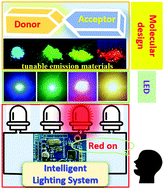Tunable fluorescence emission for multi-color light-emitting diodes and voice-activated intelligent lighting applications†
Abstract
With the development of microelectronics technology, personalized intelligent lighting and lighting control systems have been widely utilized in smart buildings to save energy, facilitate people's lives, and decorate our community environment. This article presents four bipolar molecules (1–4) with bright color-tunable emission from blue (446 nm) to red (637 nm) light, which were designed and synthesized via constructing a pull–push system. Moreover, these highly thermally stable molecules with tunable fluorescence emission were used as highly efficient emitters for fabricating stable RGB LED devices with a considerable color rendering index (CRI). Furthermore, we designed an electrocircuit system to control green, red and yellow LED devices using an “ON” and “OFF” switch via voice-activated microelectronics technology. Thus, this study not only provides a molecular strategy to construct tunable-emission materials for multi-color LED device applications, but also offers an efficient example for combining organic synthesis with electronic devices to realize a personalized intelligent lighting and light control system via microelectronics technology.



 Please wait while we load your content...
Please wait while we load your content...